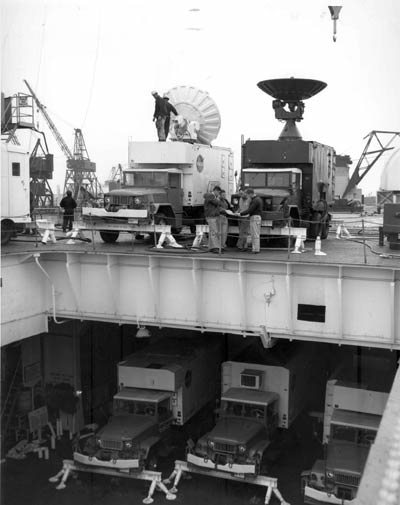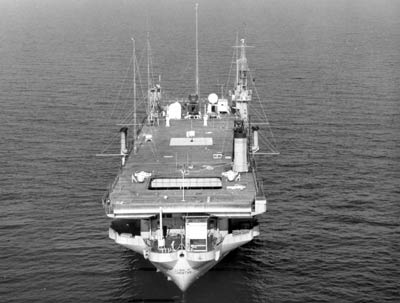Rocket shipby Dwayne A. Day
|
| NASA participated in the International Quiet Sun Year in numerous ways, and one of the most unusual involved equipping a World War 2 era escort carrier with dozens of sounding rockets and setting it sail on the oceans. |
Croatan was built during World War 2 as a “jeep carrier”—a small aircraft carrier generally used either for anti-submarine support to merchant convoys, or to provide air support to naval task forces. She was laid down on April 15, 1942, launched on August 1, and commissioned as USS Croatan, CVE-25 (CV=“carrier of heavier than air aircraft” E= “escort”), on April 28, 1943. Like other escort carriers, she received a name of a maritime geographic feature, in Croatan’s case a sound on the North Carolina coast. She served honorably, if unspectacularly, in the Pacific during World War 2 and was decommissioned on May 20, 1946. But after nearly twelve years in mothballs she was reactivated in 1958 as an aircraft transport and ferried military aircraft around the world until 1964 when she was assigned a new task for NASA.
The project was designated the Shipboard Sounding Rocket Experiments Program and did not involve substantial alterations to the ship itself. Instrument trailers were parked in the Croatan’s hangar bay and several vans equipped with radar dishes were parked on her flight deck. Other equipment, including telemetry and tracking antennas, were also mounted on her flight deck near her forward elevator. Launchers for Nike-Cajun and Nike-Apache rockets were positioned on each side of the aircraft elevator at the ship’s stern.
The project was run by NASA’s Wallops Island Station in Virginia. Wallops was NASA’s most active site for conducting sounding rocket launches and thus was the obvious choice for leading the project. The Croatan was based in Baltimore, not far up the coast from Wallops.
The Croatan gave NASA a mobile launching platform that could reach areas that normally could not be reached by sounding rockets, particularly the region of the magnetic equator. They provided upper atmosphere and ionosphere measurements that were correlated with worldwide scientific studies.
 Instrument trailers for the National Aeronautics and Space Administration's Shipboard Sounding Rocket Experiments are positioned aboard the U.S. Naval Ship Croatan in preparation for a shakedown cruise to test the equipment and operational procedures. The mobile launch platform permitted rocket soundings in areas not accessible from land-based launch sites, particularly in the region of the magnetic equator. The experiments were part of the International Quiet Sun Year 1964-1965. The photograph is from 1964. |
Many of the experiments were run by individual scientists associated with universities. In the fall of 1964 one of the scientists in charge of the sounding rocket project, S.A. Bowhill, prepared to conduct aeronomy research aboard the ship. Bowhill’s research was typical of the experiments planned for the Croatan’s cruise. Bowhill was studying the lower portions of the ionosphere, a portion of the atmosphere that ranges from 50-250 miles (80-300 kilometers). Bowhill worked on designing a vertical incidence sounder that was installed in an equipment van and loaded aboard the Croatan. He also installed antennas on the ship and during an October shakedown cruise the new equipment was tested.
During a second shakedown cruise in November, twenty-five Wallops Station personnel were on board the ship to check out facilities and conduct seven scientific experiments. They brought with them five launchers and eighteen mobile vans of radar and telemetry tracking equipment and conducted half a dozen launches over an eight-day period. They launched rockets at dusk on November 10 and 11 and again at dawn on November 12 to deploy sodium vapor cloud experiments for NASA’s Goddard Space Flight Center. On November 17 they launched an experiment to measure air density and temperature and on November 19 they launched two Nike-Apache rockets. One of them was one of Bowhill’s experiments to measure electron density in the ionosphere, and another was a University of Michigan experiment to measure pressure, temperature and density in the region of about 20-75 statute miles. That same day NASA launched another Nike-Apache from Wallops Island with one of Bowhill’s experiments.
But this was just a prelude to the big show. After the shakedown cruise the NASA equipment was returned to Wallops Station and Bowhill’s sounder and equipment van were sent back to the University of Illinois for final modification in preparation for the extended cruise the following spring.
In late February 1965 the Croatan set sail again, heading down the East Coast, through the Gulf of Mexico and through the Panama Canal and south, arriving at Lima, Peru on March 13. She fired several rockets along the way, averaging about two to three per day. Between her departure from Balboa in the Panama Canal Zone and her arrival at Lima the ship fired ten two-stage sounding rockets carrying upper atmosphere and ionosphere experiments for the University of Michigan, the University of New Hampshire, and Goddard Space Flight Center. The ship also fired three single-stage Arcas meteorological rockets, two of them carrying experiments for measuring ozone in the atmosphere. The launches took place from five degrees north to about 11 degrees south of the Equator.
| It is a cliché to say that old warships often become razor blades; in reality, their steel ends up in a variety of places. But no matter how the Croatan’s steel ultimately was used, she still has an unheralded, but respectable, legacy in the service of science. |
At Lima the ship took on additional experimenters and equipment for the next leg of the journey, which started on March 15. On March 18 she fired four Nike-Apaches to conduct plasma and ionospheric measurements. After over a week at sea the ship returned to Lima to again take off some experimenters and take others aboard for the next part of the trip. She continued this pattern for almost a month, and April 13 she fired five sounding rockets during the day. Her last launch was a Nike-Apache on April 15, after which she set sail for home as her researchers began assessing the data that they had collected during her brief sojourn—a period during which they had fired seventy-three sounding rockets off the Croatan’s deck, including five of Bowhill’s experiments; certainly more action than she had seen since the Second World War. During the voyage, the ship’s crew consisted of about seventy-five civil service personnel with a launch team made up of about thirty engineers and technicians from Wallops Station. The number of scientists varied from eighteen to thirty-two.
After the NASA and other experimental equipment was removed from the ship the Croatan returned to more boring—not to mention quiet—duties carrying airplanes and helicopters around the world. On October 23, 1969, she was decommissioned for the last time, stricken from the Naval Record on September 15, 1970, and sold and scrapped in 1971. It is a cliché to say that old warships often become razor blades; in reality, their steel ends up in a variety of places. But no matter how the Croatan’s steel ultimately was used, she still has an unheralded, but respectable, legacy in the service of science.
